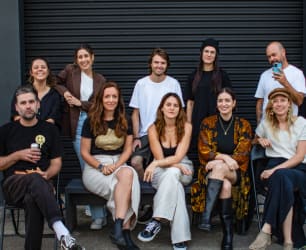The Gold Coast is a relatively young city and still growing. To get a snapshot of who we are and where we came from, we look at ten of the city’s most significant cultural moments:
1. The longest and strongest cultural imprint on the Gold Coast is in the Dreamtime of Kombumerri folk. Fascinating storylines travel across the Gold Coast, along waterways and out to sea. These stories are not mine to tell but I encourage readers to listen when they are shared by traditional custodians.
2. On the 16 October 1894, The Telegraph (Brisbane) writes of a “trip by the Maid of Sker…availed of by some 250 people, and quite an enjoyable day was spent on the main beach.” This event wouldn’t be described as significant, but rather an example of the overall significance of this coastal paddle boat steamer for early settlers. This trusty vessel ferried passengers and freight between Brisbane, Southport and Nerang for over 50 years. Its hull now rests in Nerang’s Bischoff Park.
3. The formal opening of the South Coast Railway was on 24 January 1889. Starting from Roma Street at 9:40am, a train carrying the Minister for Railways, railway officials and other Parliamentarians travelled to arrive at the “pretty seaside resort” of Southport at 12:45pm.
“Two special trains…were unusually long ones, they were crowded with passengers. Many persons availed themselves of the opportunity to spend a holiday, and picknickers formed the majority of the excursionists.”
4. Tragedy marked 6 January 1916, when Robert Doran, a 47-year-old accountant from Brisbane, lost his life swimming at Kirra beach. From the turn of the century, day trippers from Brisbane were visiting South Coast beaches in increasing droves. Sadly, swimmers weren’t always used to the conditions on these unpatrolled beaches. The day after Mr Doran’s death, a public meeting was held at Coolangatta Town Hall and a decision was made to form the Kirra Surf Life Saving Club.
5. From August 1942 until the end of WW2 in 1945, American service men and women would take leave for rest and recreation in one vast leave area along the coastline from Southport to Coolangatta. The US Army Air Corp also set up a radar station at Point Danger. These areas were off-limits to locals. Many monuments of these R&R areas can still be found today, such as beach picnic shelters and other infrastructure.
6. After decades of failed attempts by developers and farmers to subdivide the 27.6 hectares of natural reserve headland of Jellurgal, Burleigh Heads National Park was gazetted in 1947. On 3 December 1950, ‘Koala Park’ on the headland was opened as a public drawcard. Thousands of visitors flocked to try to glimpse any of the local twelve koala families.
7. Gold Coast accommodation was fairly modest until post-war 1950s, when the city’s vision grew to include world-class holiday resorts. The five-storey Lennons Hotel was built in 1956 on a former sand mine in Broadbeach. In 1959, the ten-storey Kinkabool building was the first high-rise constructed in Surfers Paradise.
8. Our love for shopping centres started with the Sundale Shopping Centre. Built in 1968 it became a hotspot for not only shoppers but also for celebrities like Graham Kennedy and Bryan Brown, popping in to do live radio performances at the resident 4GG radio station.
9. In March 1977, the Stubbies surf competition firmly established the Gold Coast as a world-class surfing destination. This was the first man on man competition in the country, drawing a crowd unseen since and still a strong part of local lore. Michael Peterson dominated the event and sealed his place as one of the best surfers in Australia’s history.
10. Gold Coast’s first theme park, Magic Mountain, was opened at Nobbys Beach in 1962. In 1987, its infamous chairlift ride was moved to Dreamworld, which had opened in 1981. Magic Mountain closed permanently in 1991 but its heyday has left its mark on many locals and visitors.
There are a million moments and memories that made the Gold Coast who and what we are. What are yours? Tell us at news@blankstreetpress.com.au.
THIS PIECE WAS CREATED FOR BLANK'S SPECIAL 100th EDITION, DISTRIBUTED IN MARCH 2023.















